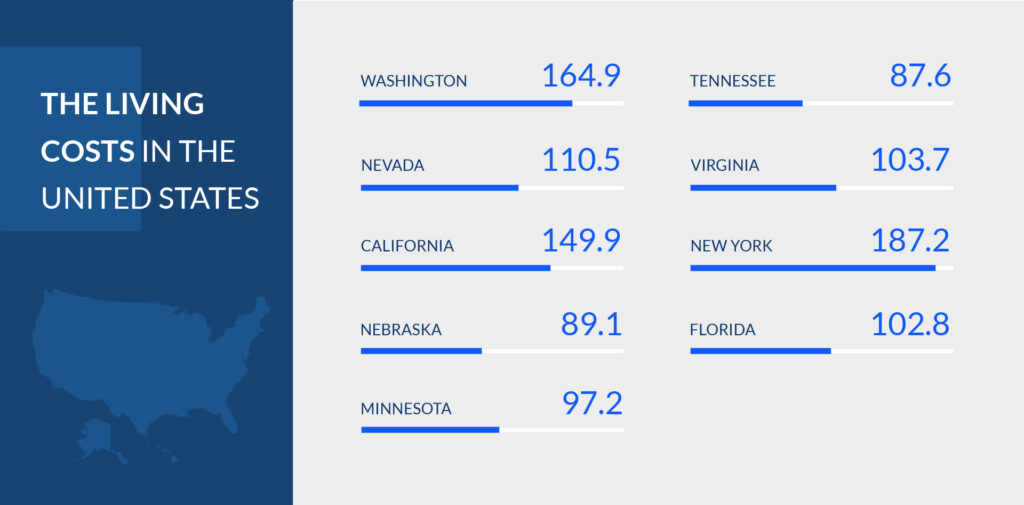With over 6000 moving companies in the US alone, one has to wonder where are all of those movers getting their money’s worth from. That is to say, all of them need to have enough customers in order to remain in business. This can only lead us to one conclusion – Americans are moving, a lot. Whether locally, cross country, or internationally, the US gets to witness a lot of its residents migrating annually. And this is where we come to the question of what are Americans’ reasons for moving. As this is by no means a simple query, the answer is not as straightforward as you might hope. Still, it is worth exploring, and that is exactly what we are going to do through the following article.

Changing home is never easy, even when it is within the US. That is why the reasoning behind it has to be sound.
Americans’ reasons for moving that they share with the rest of the world
Like every nation, Americans do have their particular reasons for moving. That being said, they are still people (funny but true), and as such share the reasons behind the relocation as every other person:
- Upsizing or Downsizing Home
- Job Relocations
- Marriage or Retirement
- Changing Neighborhoods
- Financial reasons
Now, let us delve deeper into these rationales.
Upsizing or Downsizing home
To the vast majority of people, the course of life is not something you cannot predict with great accuracy. That is why certain adjustments have to be made from time to time, sometimes smaller, and on other occasions bigger. Relocation definitely falls in the latter group. Simply put, one does not downsize or upsize a home on a whim. As it is a complex undertaking, it has to be backed up by an undeniable necessity. Whether for marriage, a growing family, empty nesting, or simply an increase in wealth, housing changes can truly be called for. Moving into a larger or smaller house to accommodate life’s changes makes up a majority of Americans’ reasons for moving, regardless of whether they are welcoming a growing family or watching their adult children go off to college or their own homes.
Moving for a job
The Bureau of Labor Statistics claims that the average American holds their current job for an average of 4.6 years. As this points to occupational mobility, it also includes mobility regarding post-graduate studies, or changing careers. This further indicates that it is possible that after about 5 years, an individual will land a new job in a new city or state. After all, landing a job that is in proximity to your place is a rather lucky occurrence, especially if you are looking for a particular job position. And no one can dispute that the commute time is a big factor in every person’s life.

The better job opportunity is one of the main Americans’ reasons for moving
Relocation for marriage
Virtually every marriage and divorce call for relocation. As a major change in life, it requires relocation into a suitable home that will meet the newly occurring needs. This relocation can be within the general area, or further away.
Moving after retirement
While some are just beginning their family and welcoming some big changes, others are ready to slow down and focus more on relaxation. Retirement usually signifies the time to clean out those old closets and spare bedrooms. It is at that point that people realize living in a smaller home somewhere where it’s warmer and calmer might be just the thing they need. And it is that realization that often stands behind people moving after they retire.
Changing the neighborhood
There are plenty of reasons why someone may decide to move from one neighborhood to another:
- gentrification
- safety
- economic changes
- social factors
- better school system
- other
Whatever the reason may be, the changing of the neighborhood is another of the main reasons why Americans choose to move.
Financial reasons
The living costs in the US differ greatly as you go across the country. If we say that the average US costs of living are a 100, here’s how states across the country will compare:
- Washington – 164.9
- Nevada – 110.5
- California – 149.9
- Nebraska – 89.1
- Minnesota – 97.2
- Tennessee – 87.6
- Virginia – 103.7
- New York – 187.2
- Florida – 102.8
As you can see, life in New York does not cost the same as it does in Nebraska. While the major reason behind these differences is in housing costs, there are other factors like groceries, utilities, and health care that also play a role in the overall living expenses. Changes in a person’s life that imply a financial impact can and often do call for relocation. Simply put, people cannot always afford to live in Manhattan and have to opt for a more affordable neighborhood in Minnesota.

Let’s face it, money almost always plays a role in major life decisions.
Where are Americans moving within the US and why?
Once you consider all of the reasons we have listed, you might be wondering where would an American faced with such situations choose to move to. Here are the statistics we have come across:
- The top three states for outbound relocations are Illinois, California, and New Jersey.
- Minnesota came back as the sixth highest state for outbound moves after not being in the top eight the year before.
- Connecticut took eight place as the state with the most outbound moves, also not being in the top eight before.
- Considering inbound moves, the top five states include Idaho, Arizona, South Carolina, Tennessee, and North Carolina.
Considering Northeastern states
The northeaster states rank high for outbound moves. They have not placed within the top eight states for inbound moves since 2015. Illinois came in first for outbound moves, and it is the 5th time in the last 6 years that it has taken the lead in this category. Connecticut was oscillating between fifth, sixth, second, falling off the list, until it moved back in eighth place last year. Both New Jersey and Pennsylvania have consistently been in the top 8 outbound moves since the study began in 2015. Now, certain data suggest that Americans move out of the Northeast mostly for these reasons:
- It has some of the least tax-friendly states.
- The weather is not favorable, as it tends to have bone-chilling temperatures.
- Many companies move for lower costs
Considering Southern states
The southern states rank within the top eight for inbound moves only, while they have not ranked for outbound moves since the study began. South Carolina consistently ranks high for inbound moves, never falling beneath fourth place. South Carolina is also one of the highest-ranked, having just a small fall for inbound moves between 2018 and 2019. Tennessee has risen steadily in the rankings for inbound since 2015, arriving at number four in both 2018 and 2019. Florida has stayed within the top eight states for inbound moves since 2015, remaining at or around sixth place since. North Carolina fell from third to fifth place for inbound moves in 2018 and 2019. Texas keeps its eighth places for inbound moves. Georgia was ranked eighth for inbound moves in 2016 and 2017. However, it has since fallen out of the rankings and was not in the top eight since.

Southern states are rather popular with the Americans who are looking to move.
Now, why does it seem like the Southern states have the influx of moves? Well, the reason as the same as the ones for Northeastern states, except that they point in the opposite direction.
- States have great taxes
- Climate is warmer
- They are growth-friendly when it comes to jobs.
Regarding Midwestern states
States in the Midwest typically rank for outbound moves, until you reach Colorado. This state ranked sixth for inbound moves in 2018 before falling to seventh place in 2019. Minnesota has been circling around seventh place for the past two years, while it used to be at the top in previous years. Illinois, however, is the true leader here, having ranked in the top spot for 5 out of the last 6 years. And, just like Illinois, Michigan has consistently been a member of the states with the most outbound relocations.
Regarding Western states
The western states are mixed, with rankings for both outbound and inbound relocations. Idaho is on the top of the charts most years when it comes to the latter, except for 2017 when it was ousted by Arizona. Now, Arizona consistently tops the chart for inbound moves as well. This is possibly due to it being one of the favorite retirement destinations. It’s ranked second every year since 2015, with the only exception being in 2017 when it ranked number 1. And, it was only one percentage point behind Idaho in 2019. There are two Western states that seem to always find their place among the states with the most outbound moves, and those are Washington state and California.
What are particularly Americans’ reasons for moving overseas?
Now, moving within the state is one thing, but we cannot exclude those Americans that choose to find their happiness overseas. Now, what might their reasons be behind such a drastic change? Well, we have recognized a few main ones, and will further elaborate.
Some people like to work on improving their language skills
There is plenty of easily accessible countries for American citizens whose first language is English or Spanish. Being that they are both so widely spoken, it is easy to move somewhere where you will have no problem communicating from the very first day you move to your new country. However, for some American expats, the main reason for an overseas relocation lies in the opportunity to learn a language. Moving to the country where the language of choice is the first spoken is probably the quickest and easiest way of learning that language. Simply put, being completely exposed and absorbed in another culture and having to speak that language every day will do its magic. And, let’s face it, being able to speak another language, especially with the fluency of a local, has far-reaching benefits both in a social and professional way.

Moving overseas does have its benefits for a number of American residents.
Financial freedom that other countries offer
It’s no secret that plenty of overseas territories have a much lower cost of living than the US. And it is just this lower cost of living that American ex-pats find alluring. The financial freedom driven by ex-pat salary leads to a more extravagant lifestyle many can enjoy. You see, for many US ex-pats, things such as buying a home or investment property, more expendable cash and even choosing private schools for their children are real possibilities and reachable realities. And it is just this change in financial prosperity that is that strong driving factor for those who plan on moving overseas from America.
The chance of buying property
This reason falls under the category of the previous one, but it still deserves its due place. Namely, for a large number of US ex-pats, the chance of moving overseas is also the opportunity to put down roots in their new home country. It is due to generally strong expat wages and different financial climates that expats find it more attainable to buy a home in their new destination. The security and the financial opportunity can often be that extra push towards making the leap of moving overseas.
Exploring other continents
While the North American continent has truly breathtaking scenery and nature, there is so much in the rest of the world to see. A large number of Americans are solely motivated by their desire to go out there and explore some of it. What is also great about being an American is that with the US passport, you can virtually travel anywhere you want. US citizens who have a touch of wanderlust often find the chance to study or work overseas too enticing to miss out on.

Sure, the US is great, but the rest of the world has plenty to offer as well.
Improving career prospects in the US
Taking up a job offer overseas can often prove to be an irreplaceable experience for those looking to climb the career ladder. Whether looking for an internal career profession, or a faster route to a more senior role in another company or industry, international experience can be a true boost to those aspiring to advance in their business. For many ambitious US citizens, opting into a year or two overseas can really help them climb to the top.
Abundance of opportunities
It is thanks to the growing international companies and a larger international workforce, the opportunities to move abroad are expanding. And those US citizens with either English or Spanis as a first language can easily move to other countries where these languages are widely spoken. As you can imagine, this makes moving for work even easier. Not to mention that the US citizens have strong visa opportunities in Europe, South America, Canada, and Southeast Asia.
Migrations are not as large nor frequent as they used to be
You can say that the story of America is one of moving. After all, a total of 13.6% of Americans today were born in another country, while most of the others are descended from immigrants. And this story of migrations also includes moving within the country. Over the last 200 years, Americans have settled the frontier and relocated from cities towards suburbs. Many have migrated away from cities in the Northeast toward the South and West.
However, with that being said, the narrative that Americans are constantly moving within the country no longer holds water. Over the last 35 years, the number of Americans who have moved, either within their county, state, or out of state, has steadily declined. It is now nearly half of their previous levels. What’s more, between March 2018 and 2019, only 1.5% of Americans moved from one state to another. Only, 5.9% moved from one home to another while remaining in the same county.

Lately, Americans seem to be choosing to stay put rather than move.
What makes Americans more rooted?
The decision to move is seldom simple. Americans’ reasons for moving are rarely straightforward and clean cut. People who choose to relocate do so with the goal of searching for better opportunities. However, they must also take into account factors such as family characteristics, lifestyle, and community. Still, this has always been the case, and it is hard to link the migration decline to changes in the way people make those decisions. That being said, there are three broad changes that are certain to stand behind the outcome of these decisions.
1. Real incomes have remained flat for the last 35 years
Americans have been able to improve their standard of living only by working more and borrowing more. This includes an increase in the number of women working, which further leads to the growth of dual-income households.
The increase in both family and personal debt makes selling a house rather difficult. It also reduces the financial resources available for relocation. In the meantime, the growth of dual-income households restricts moves, having that any long-distance move would require both partners to find a suitable job in a new destination.
2. The baby boomer generation managed to squeeze younger generations out of housing and job opportunities
3. US citizens are less likely to move due to the widespread adoption of advanced information and communication technologies
Certain studies have shown that internet access was strongly associated with decreased mobility. Internet use, and likely all forms of advanced information and communication technologies allow people to remain in one place while having access to a growing array of remote employment and educational opportunities. Simply put, moving is not as necessary as it once was.

The Internet plays a major role in people’s decisions to stay home.
Advances in information and communications technologies improve the quality of information available about potential places to move to. This is bound to make decisions about whether and where to move more efficiently. It also reduces the chances that people will relocate to a place they don’t really like.
It seems that rootedness is the new normal
All indicators show that the current low levels of geographic mobility are likely to be permanent. While Americans’ reasons for moving still remain, plenty of them can be fulfilled without the relocation itself. That being said, one important principle of migration is that it is self-reinforcing. In other words, having moved once enhances the chances of moving again. It is no secret that moving is expensive, stressful, and time-consuming. Especially for people who have not migrated before. However, having moved once, additional moves become way less stressful, while new opportunities become available, and additional moves become more efficient and less costly.
What is interesting about this self-reinforcing process is that it works in the other direction as well. Those who have never moved or moved very little have a smaller chance of moving or moving again. They often view migration as risky, expensive, and disruptive. In addition, the longer a person stays in a location, the more attached they tend to grow to their home, job, and community.
Having that the current US population is more rooted than ever, it is likely that the country will continue to have lower migration rates as time goes by. Young adults who have been raised during the period of declining migration rates of the last 35 are also less likely to move simply as a consequence. And they definitely have a tendency to pass this legacy on to their own children.
Considering the impacts of a more rooted society
What can be drawn as a conclusion is that the migration decline and associated increase in rootedness will have a definite effect on American society. While Americans’ reasons for moving are not to be neglected, the fact is that relocating has grown out of style. On the other hand, rootedness has plenty of positive sides to it. Greater attachment to place and more meaningful social and community connections are just some of them. These connections to a certain place may then serve to provide social and economic support during periods of economic uncertainty we are all familiar with.

Rootedness definitely has its benefits.
Additionally, a decline in migration is likely to present a challenge to large corporations and regional economic development agencies, which rely upon migration to attract and retain talent. Lastly, the government’s approaches towards resolving regional economic disparities are bound to change. Per usual, federal and state governments have not intervened much in regional labor and housing markets. This happened under the presumption that high levels of migration serve to reallocate people from areas with few opportunities and toward areas with many opportunities.
Main Americans’ reasons for moving still remain the same, although the popularity of changing homes is not as popular as it used to be. What we can draw from this is that only the people who have no other option are more likely to move. Simply put, people who really do not have to move will almost certainly choose not to do so.





